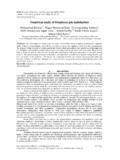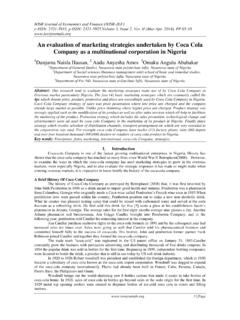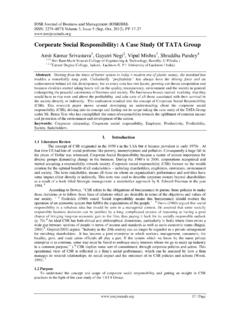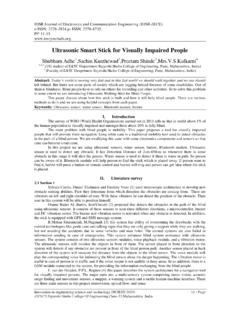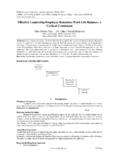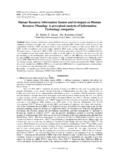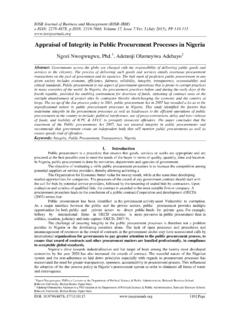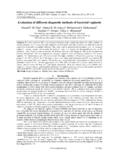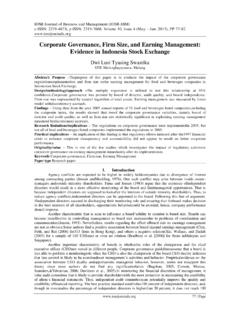Transcription of The Importance of Communication within Organizations: A ...
1 IOSR Journal of Business and Management (IOSRJBM) ISSN: 2278-487X Volume 3, Issue 2 (July-Aug. 2012), PP 40-49 40 | Page The Importance of Communication within Organizations: A research on Two Hotels in Uttarakhand 1Dr. Shipra Agarwal, 2Mr. Ashish Garg Abstract: As a feature of socially defined people, everyone is in Communication with the others in the social context. Whatever the content is, individuals should exchange and share thoughts, news, in other words they should communicate. In this regard, especially in organizations where formal and informal Communication exists, Communication within organization plays a vital role in structuring the organizational activities, objectives, company policies and strategies.
2 Key Words: Communication , information sources, interaction between employees and managers, five-star hotels. I. Introduction Communication can be defined as the exchange of an information, thought and emotion between individusals of groups; in other words, Communication plays a fundamental role in balancing individual and organizational objectives. Communication is the activity of conveying information. Communication has been derived from the Latin word "communis", meaning to share. Communication requires a sender, a message , and an intended recipient, although the receiver need not be present or aware of the sender's intent to communicate at the time of Communication ; thus Communication can occur across vast distances in time and space.
3 Communication requires that the communicating parties share an area of communicative commonality. The Communication process is complete once the receiver has understood the message of the sender. Feedback is critical to effective Communication between parties. II. Types of Communication Communication within organizations is classified into two groups as formal and informal. The types of formal Communication are up to down , down to up , horizontal and cross Communication . Nonverbal Communication describes the process of conveying meaning in the form of non-word messages. research shows that the majority of our Communication is non verbal, also known as body language. Some of non verbal Communication includes chronemics, haptics, gesture, body language or posture; facial expression and eye contact, object Communication such as clothing, hairstyles, architecture, symbols infographics, and tone of voice as well as through an aggregate of the above.
4 Speech also contains nonverbal elements known as paralanguage. These include voice lesson quality, emotion and speaking style as well as prosodic features such as rhythm, intonation and stress. Likewise, written texts include nonverbal elements such as handwriting style, spatial arrangement of words and the use of emoticons to convey emotional expressions in pictorial form III. Oral Communication Oral Communication , while primarily referring to spoken verbal Communication , can also employ visual aids and non-verbal elements to support the conveyance of meaning. Oral Communication includes speeches, presentations, discussions, and aspects of interpersonal Communication . As a type of face-to-face Communication , body language and voice tonality play a significant role, and may have a greater impact upon the listener than informational content.
5 This type of Communication also garners immediate feedback. IV. Barriers to effective human Communication Communication is the key factor in the success of any organization. When it comes to effective Communication , there are certain barriers that every organization faces. People often feel that Communication is as easy and simple as it sounds. No doubt, but what makes it complex, difficult and frustrating are the barriers that come in its way. Some of these barriers are mentioned below. Barriers to successful Communication include message overload (when a person receives too many messages at the same time), and message complexity. Physical barriers: Physical barriers are often due to the nature of the environment. Thus, for example, the natural barrier which exists, if staff are located in different buildings or on different sites.
6 Likewise, poor or The Importance Of Communication within Organizations: A research On Two Hotels In Uttarakhan 41 | Page outdated equipment, particularly the failure of management to introduce new technology, may also cause problems. Staff shortages are another factor which frequently causes Communication difficulties for an organization. Whilst distractions like background noise, poor lighting or an environment which is too hot or cold can all affect people's morale and concentration, which in turn interfere with effective Communication . System design: System design faults refer to problems with the structures or systems in place in an organization. Examples might include an organizational structure which is unclear and therefore makes it confusing to know who to communicate with.
7 Other examples could be inefficient or inappropriate information systems, a lack of supervision or training, and a lack of clarity in roles and responsibilities which can lead to staff being uncertain about what is expected of them. Attitudinal barriers: Attitudinal barriers come about as a result of problems with staff in an organisation. These may be brought about, for example, by such factors as poor management, lack of consultation with employees, personality conflicts which can result in people delaying or refusing to communicate, the personal attitudes of individual employees which may be due to lack of motivation or dissatisfaction at work, brought about by insufficient training to enable them to carry out particular tasks, or just resistance to change due to entrenched attitudes and ideas.
8 Ambiguity of Words/Phrases: Words sounding the same but having different meaning can convey a different meaning altogether. Hence the communicator must ensure that the receiver receives the same meaning. It would be better if such words can be avoided by using alternatives. Individual linguistic ability is also important. The use of difficult or inappropriate words in Communication can prevent people from understanding the message . Poorly explained or misunderstood messages can also result in confusion. We can all think of situations where we have listened to something explained which we just could not grasp. Interestingly, however, research in Communication has shown that confusion can lend legitimacy to research when persuasion fails.
9 Physiological barriers: may result from individuals' personal discomfort, caused for example by ill health, poor eyesight or hearing difficulties. Presentation of information: is also important to aid understanding. Simply put, the communicator must consider the audience before making the presentation itself and in cases where it is not possible the presenter can at least try to simplify his/her vocabulary so that majority can understand. Importance of Effective Communication : No matter how brilliant and invaluable your idea, it is worthless unless you can share it with others. For this reason, effective Communication is crucial at every level of an organization. However, the ability to communicate effectively does not come easily to many people, and it is a skill that requires practice.
10 We begin practicing our Communication skills even before we learn to walk. A newborn child communicates by crying, but it slowly learns to mimic its parents speech. Eventually, the child discovers that certain speech patterns elicit different responses; one of the joys of parenting is trying to decipher the meaning behind certain words. Does baaaaaw mean that the baby wants his ball, his bottle, or his blanket? Slowly, through trial and error, the child learns to manipulate sounds to get what it wants, and as the child develops, this active oral practice leads to more nuanced and fluid conversations. In short, the child learns effective Communication . To effectively communicate a complex idea, however, requires skills beyond elementary conversation.
